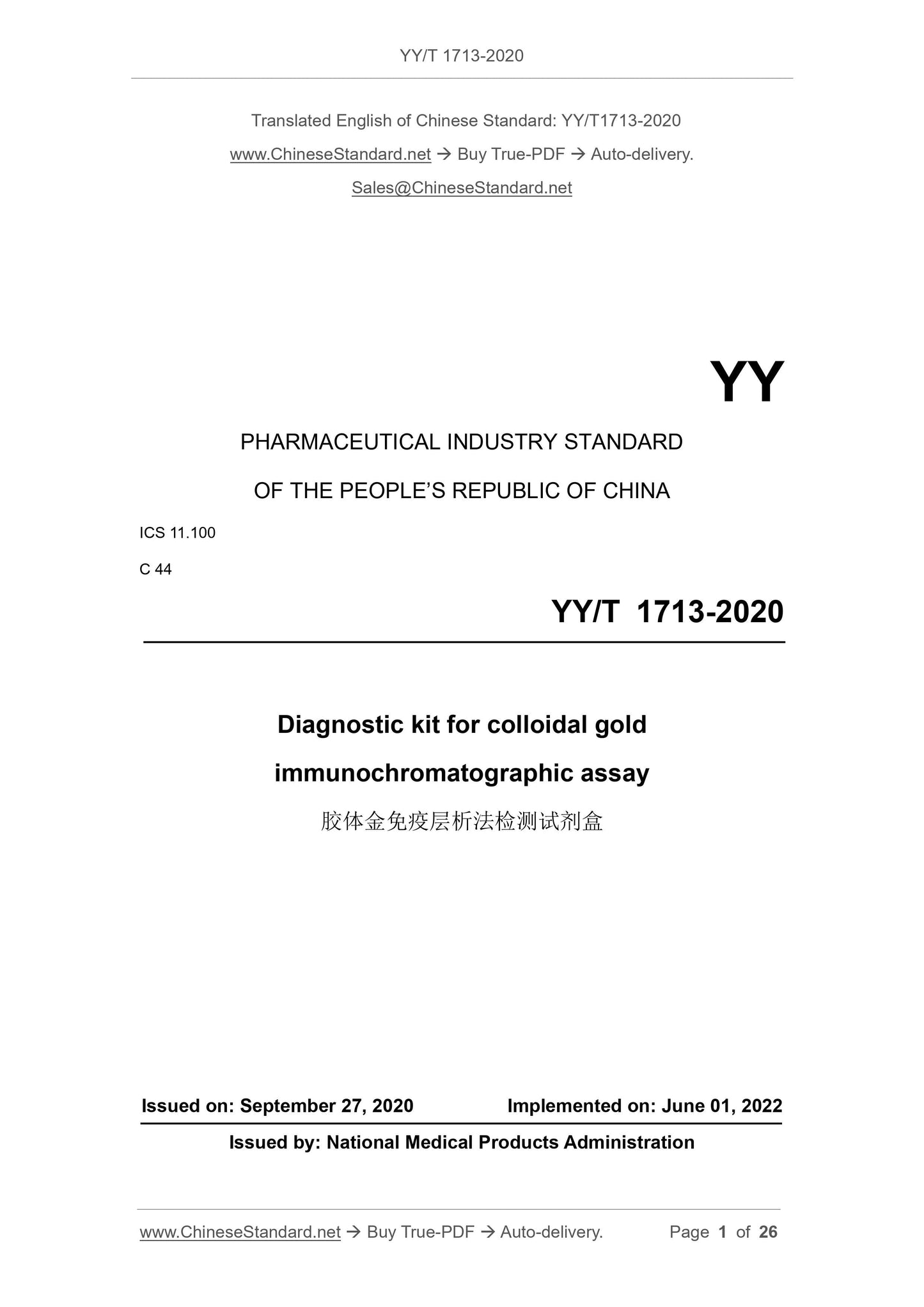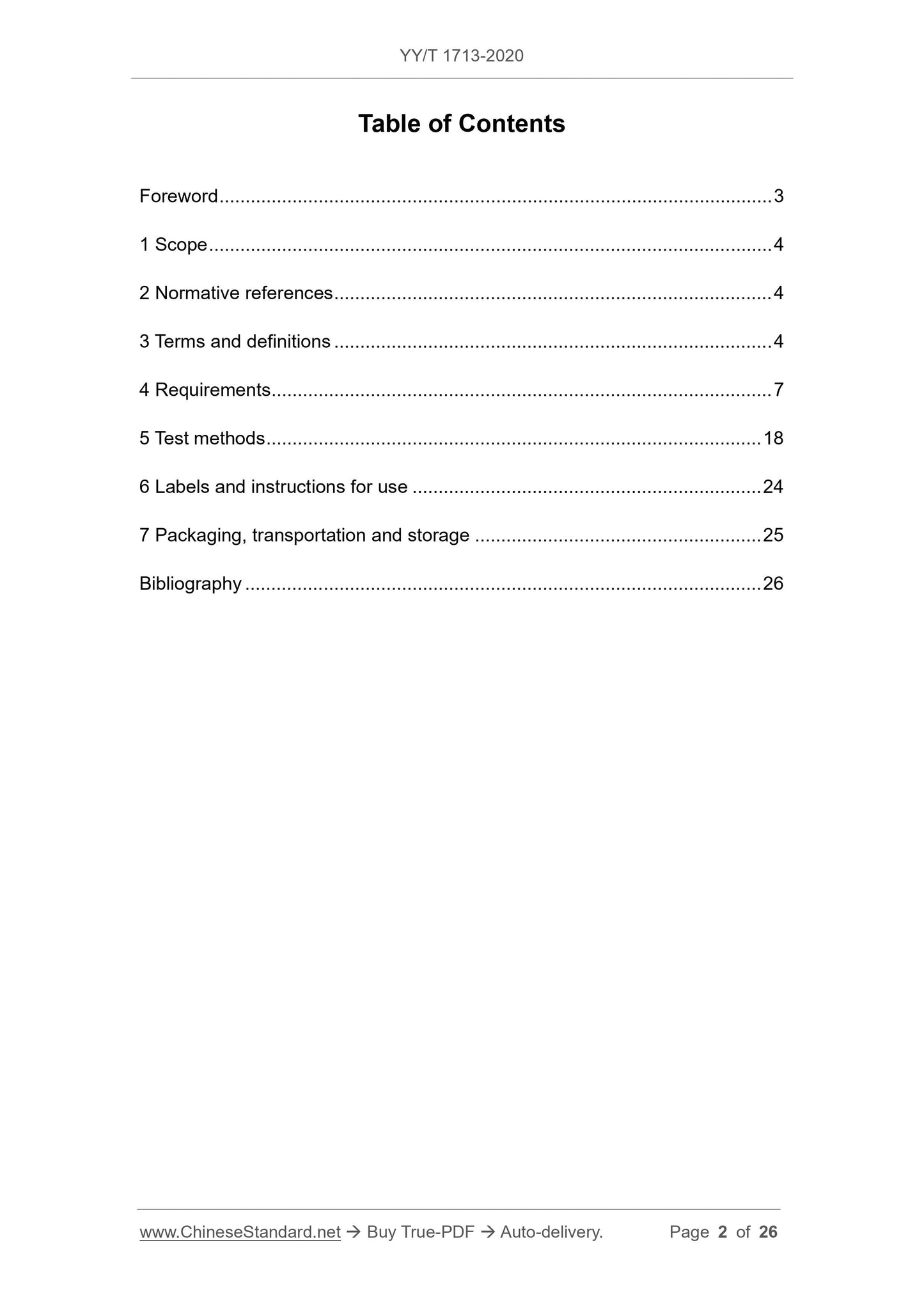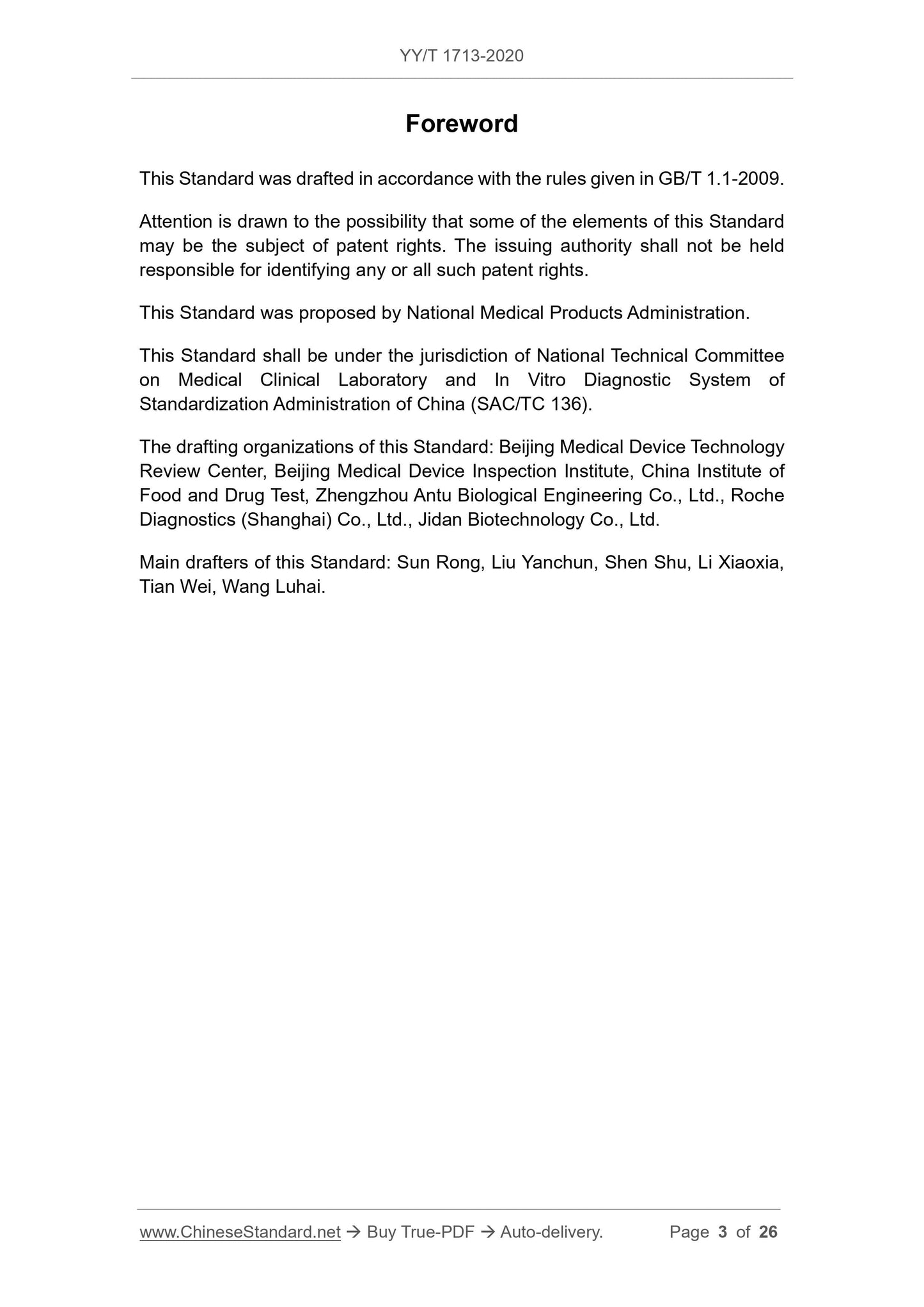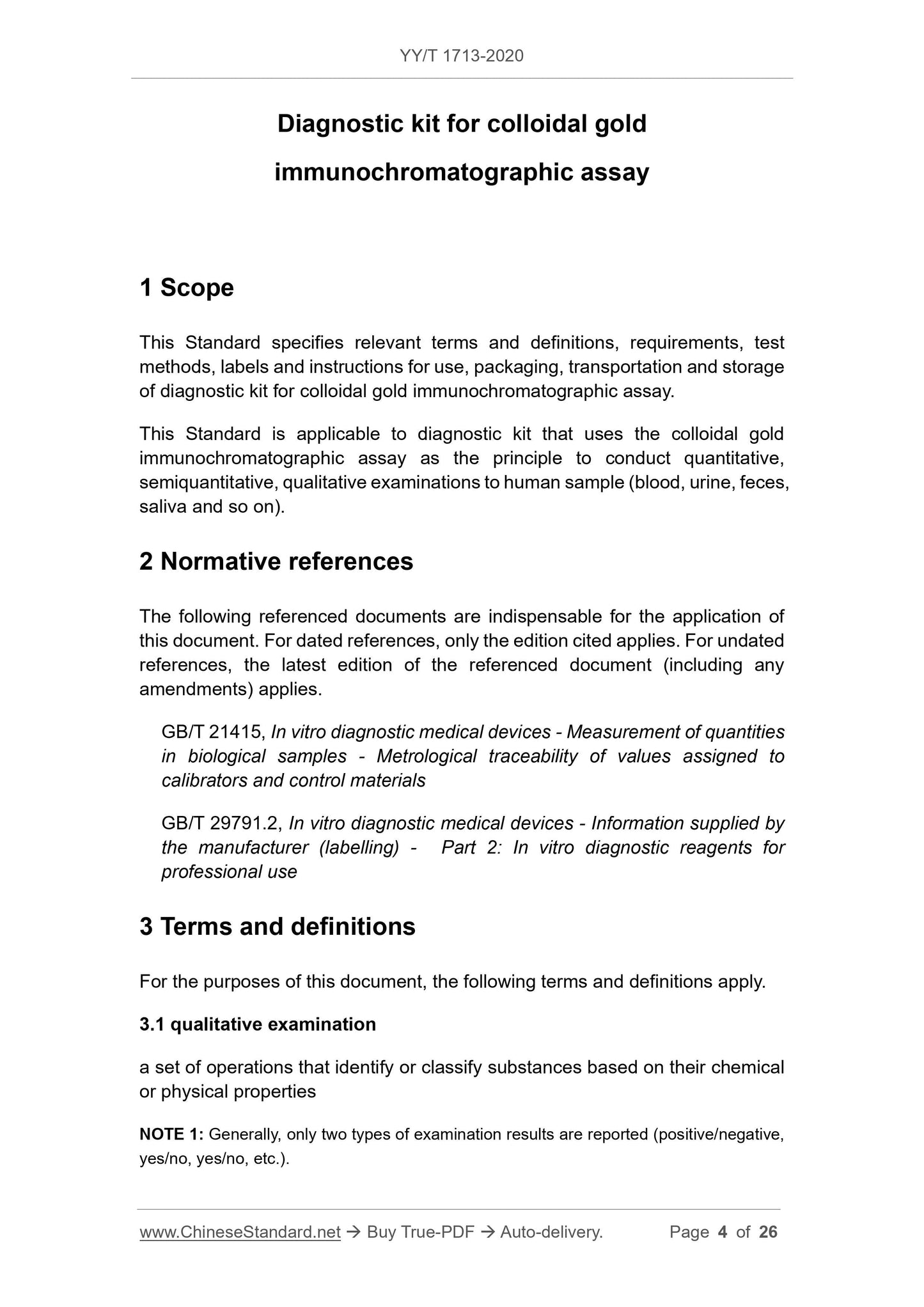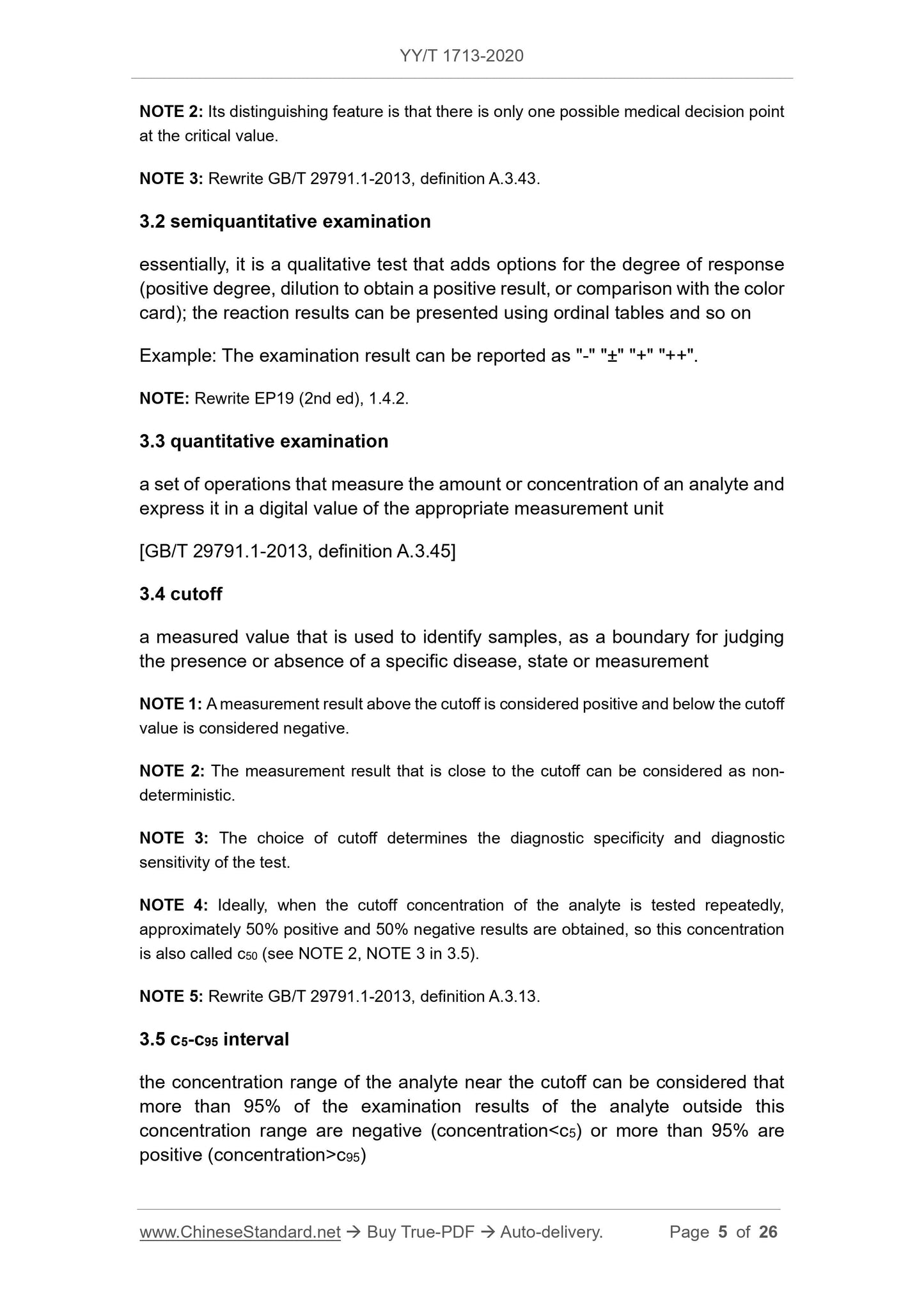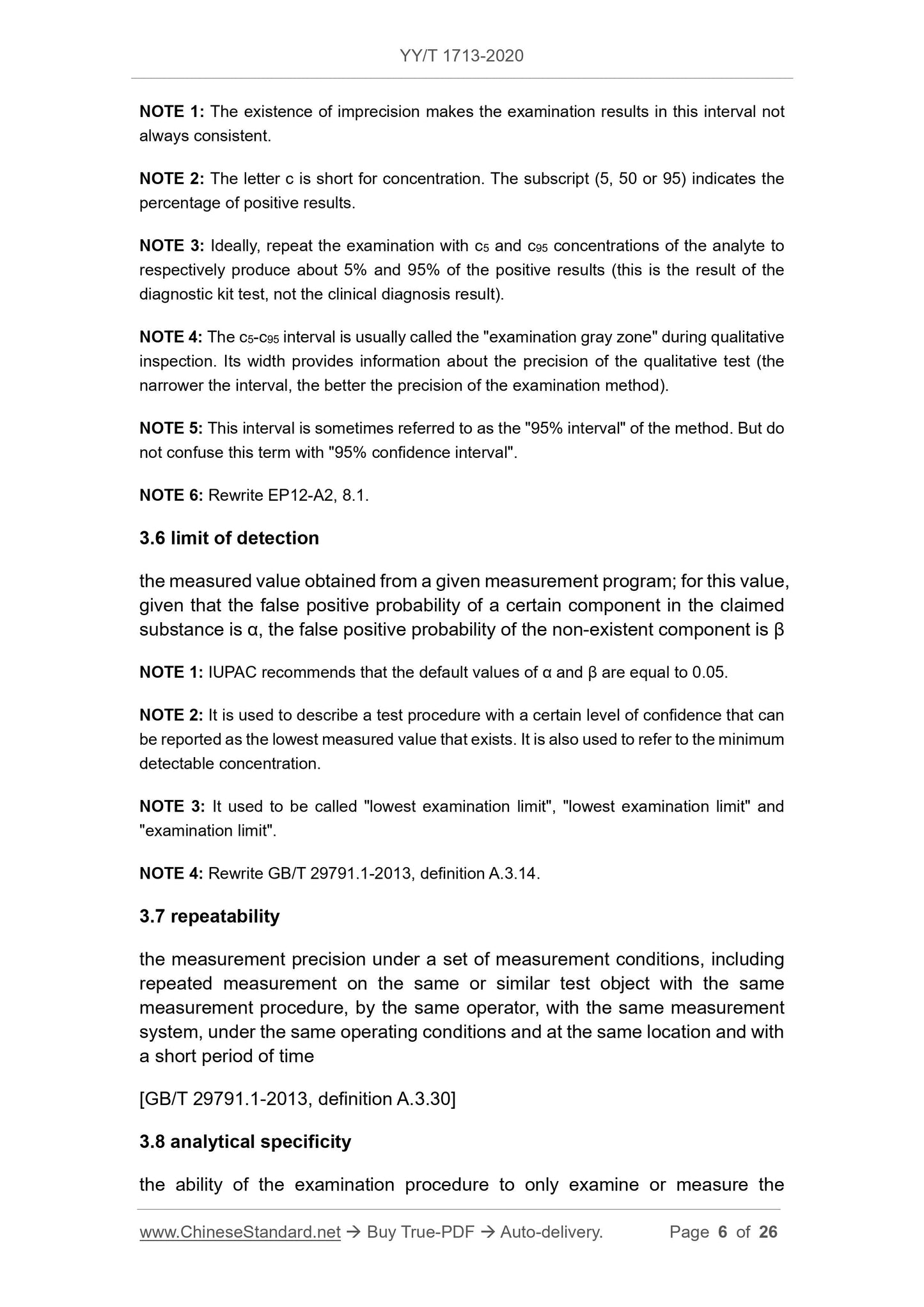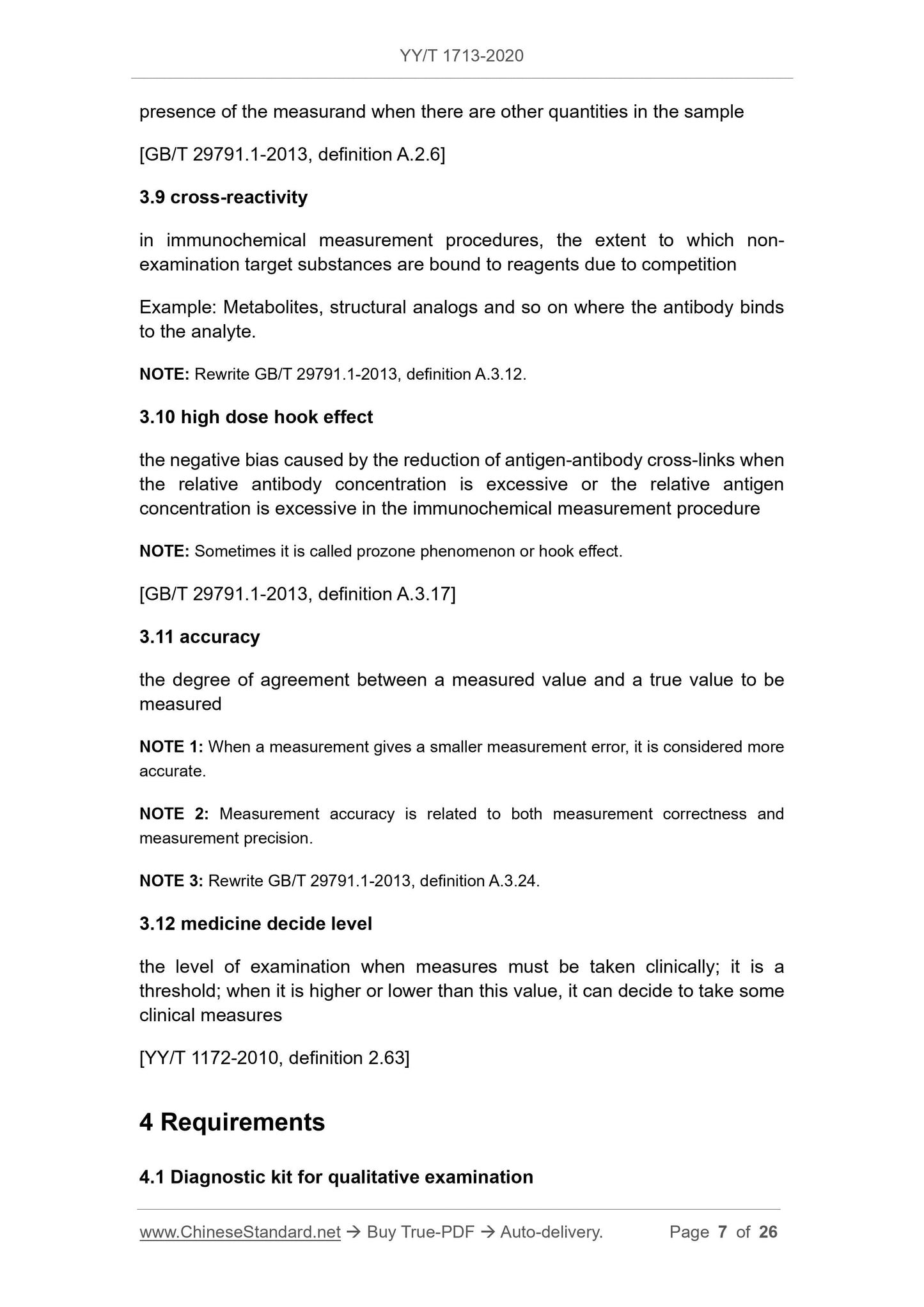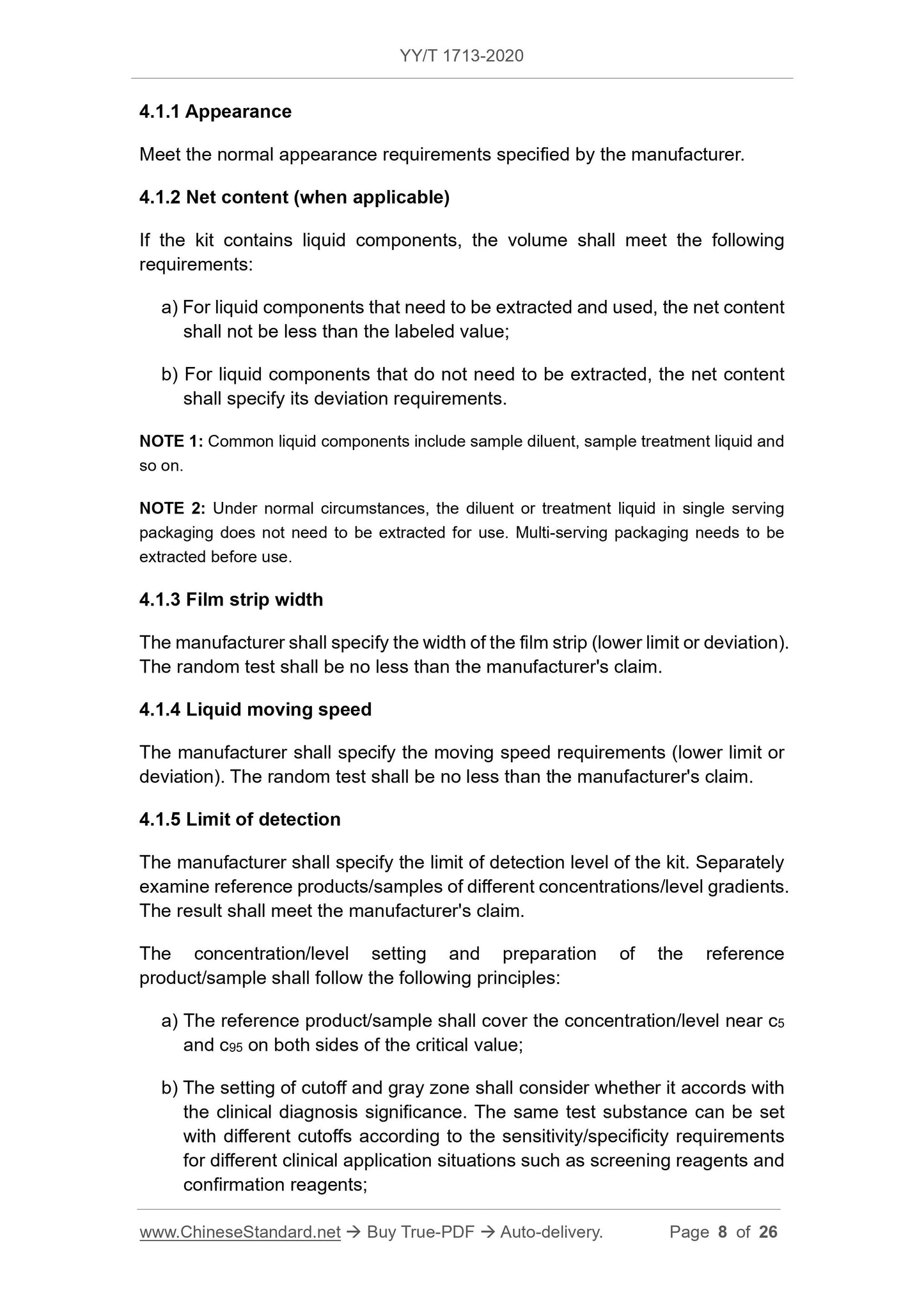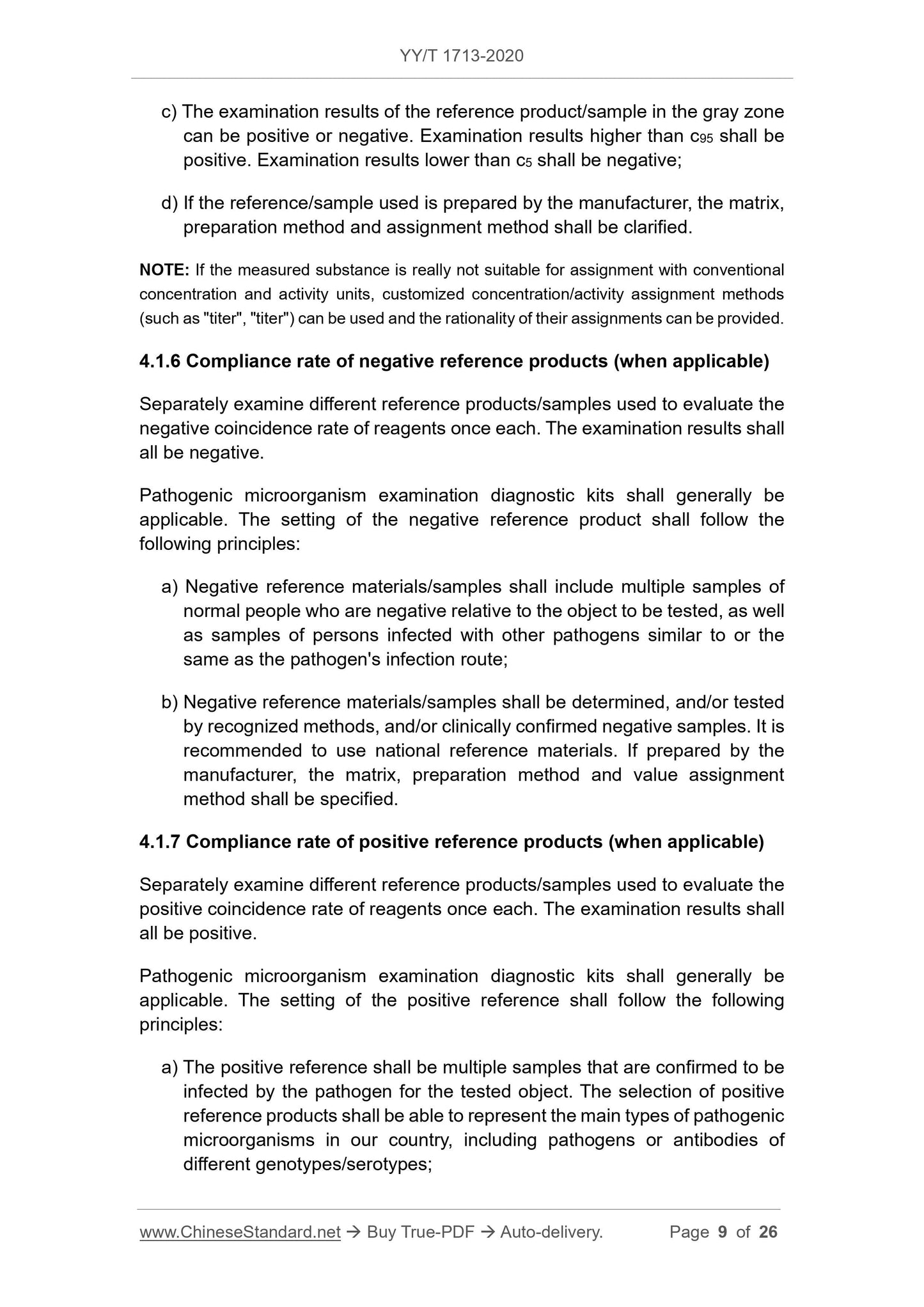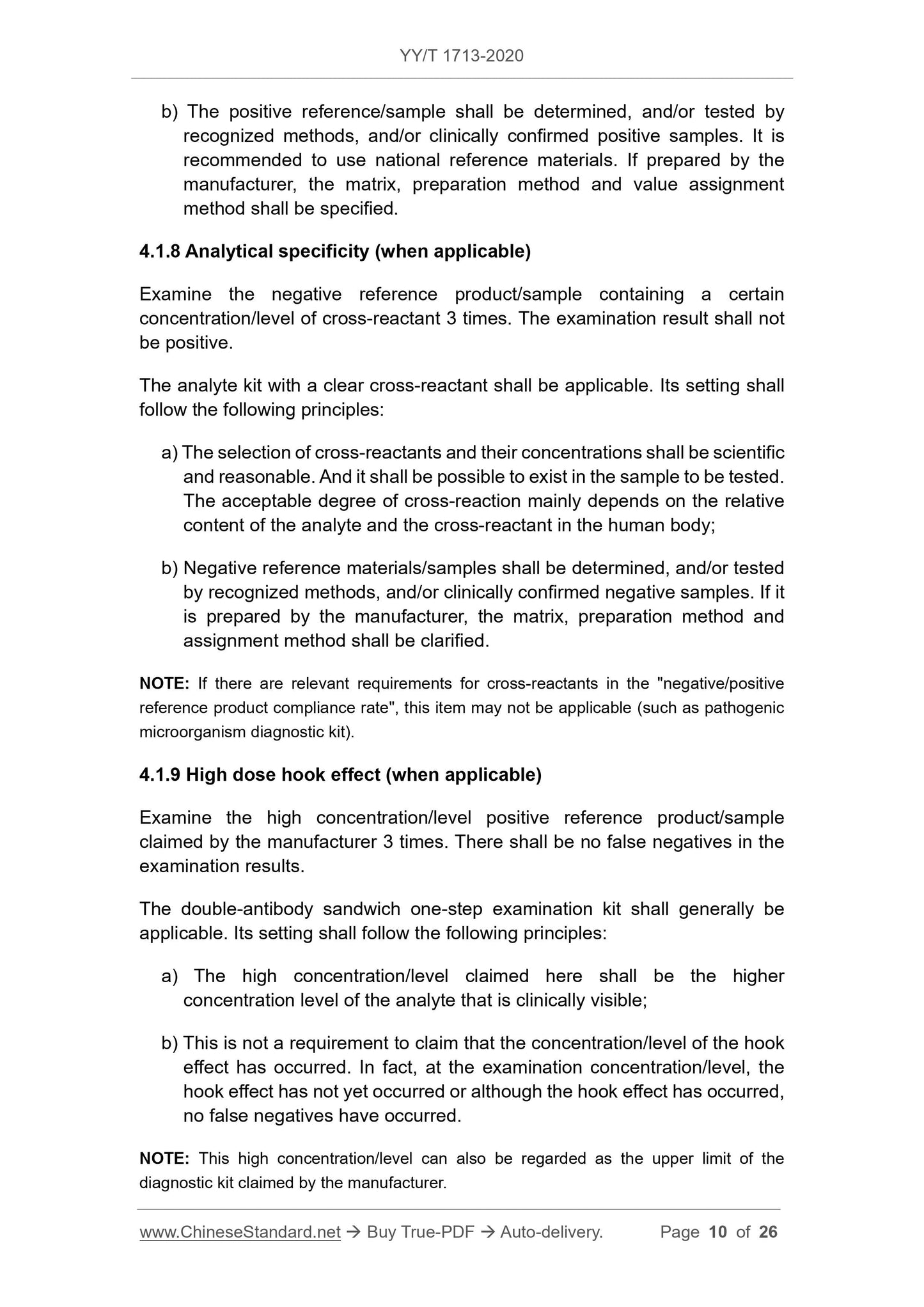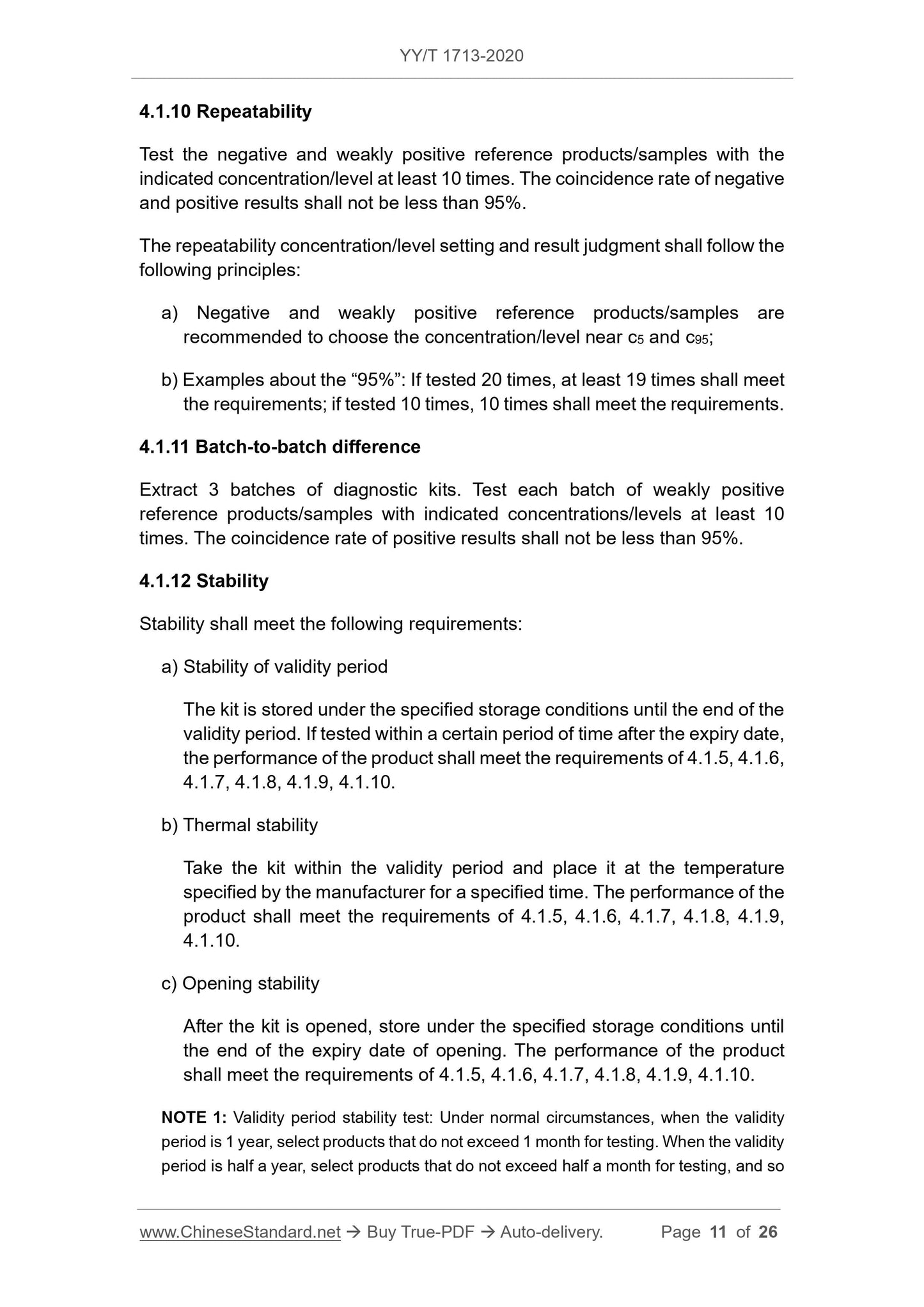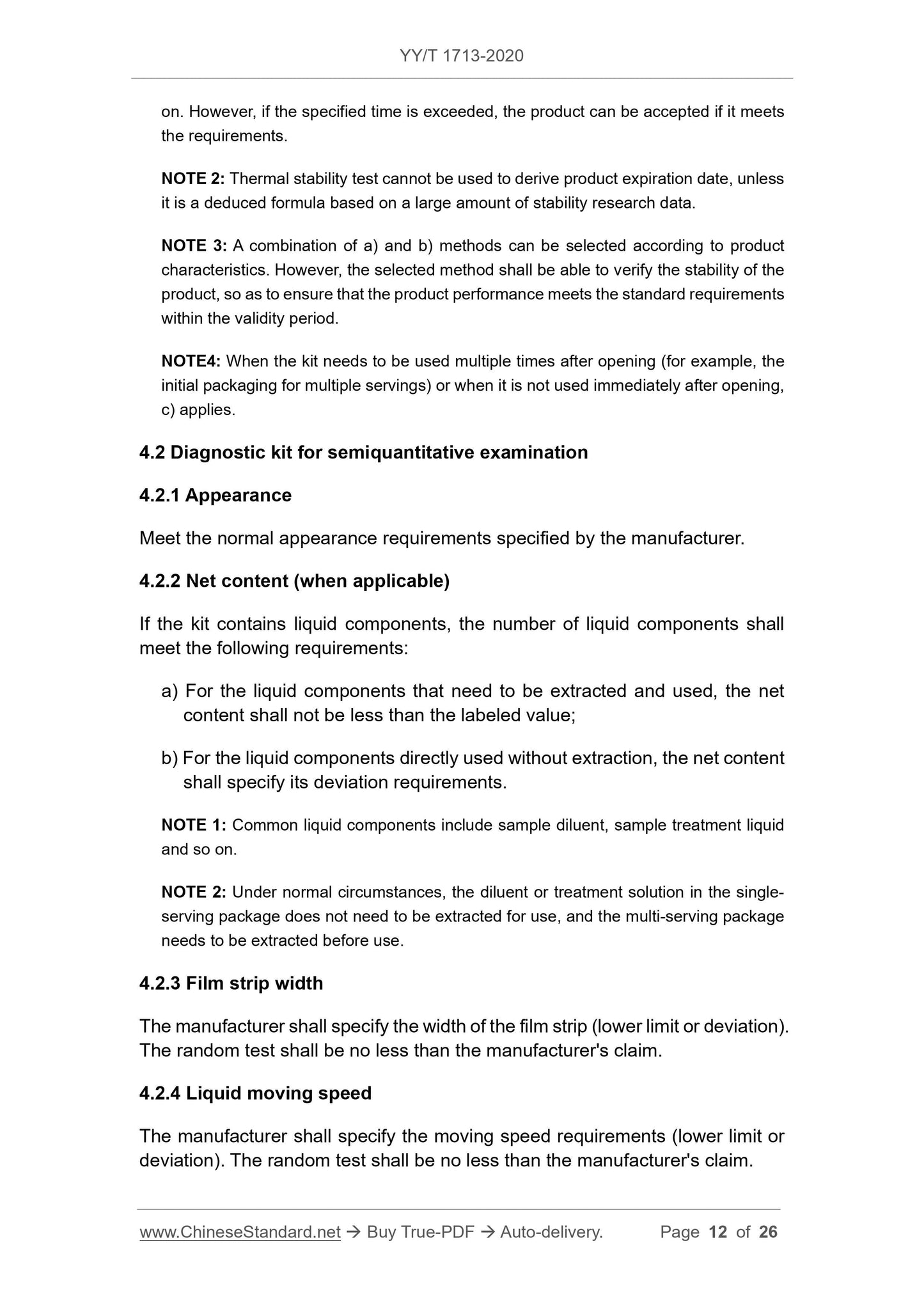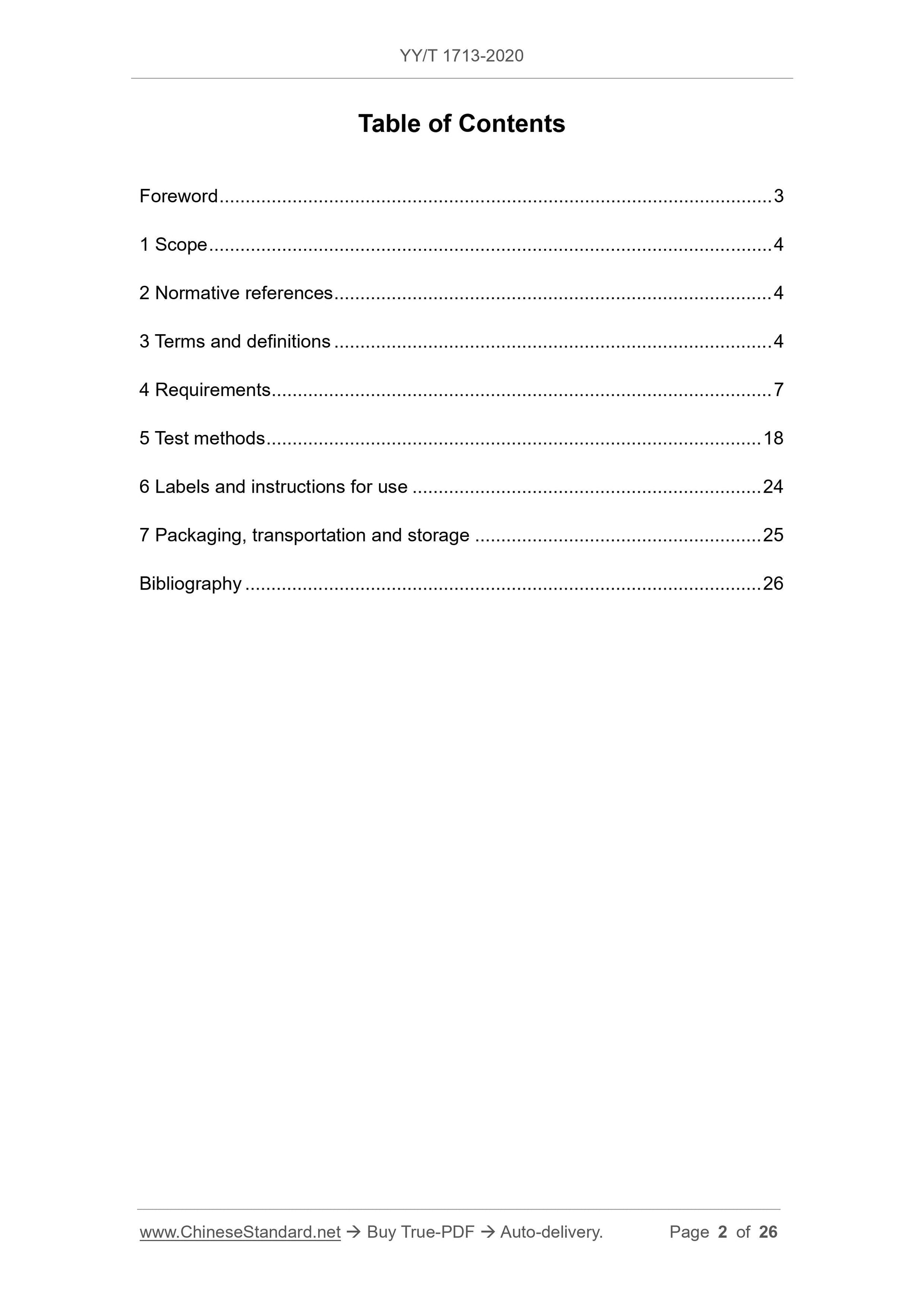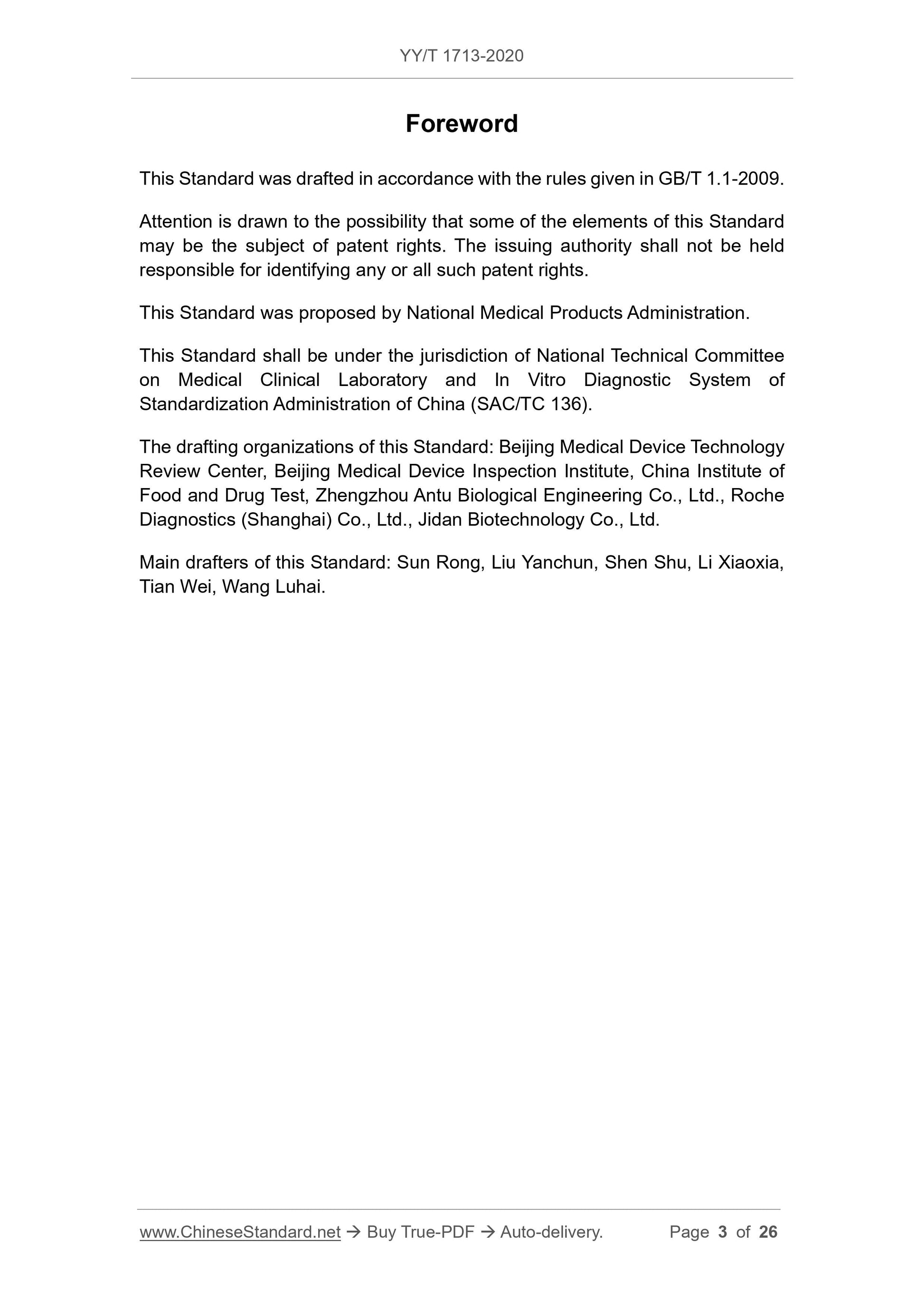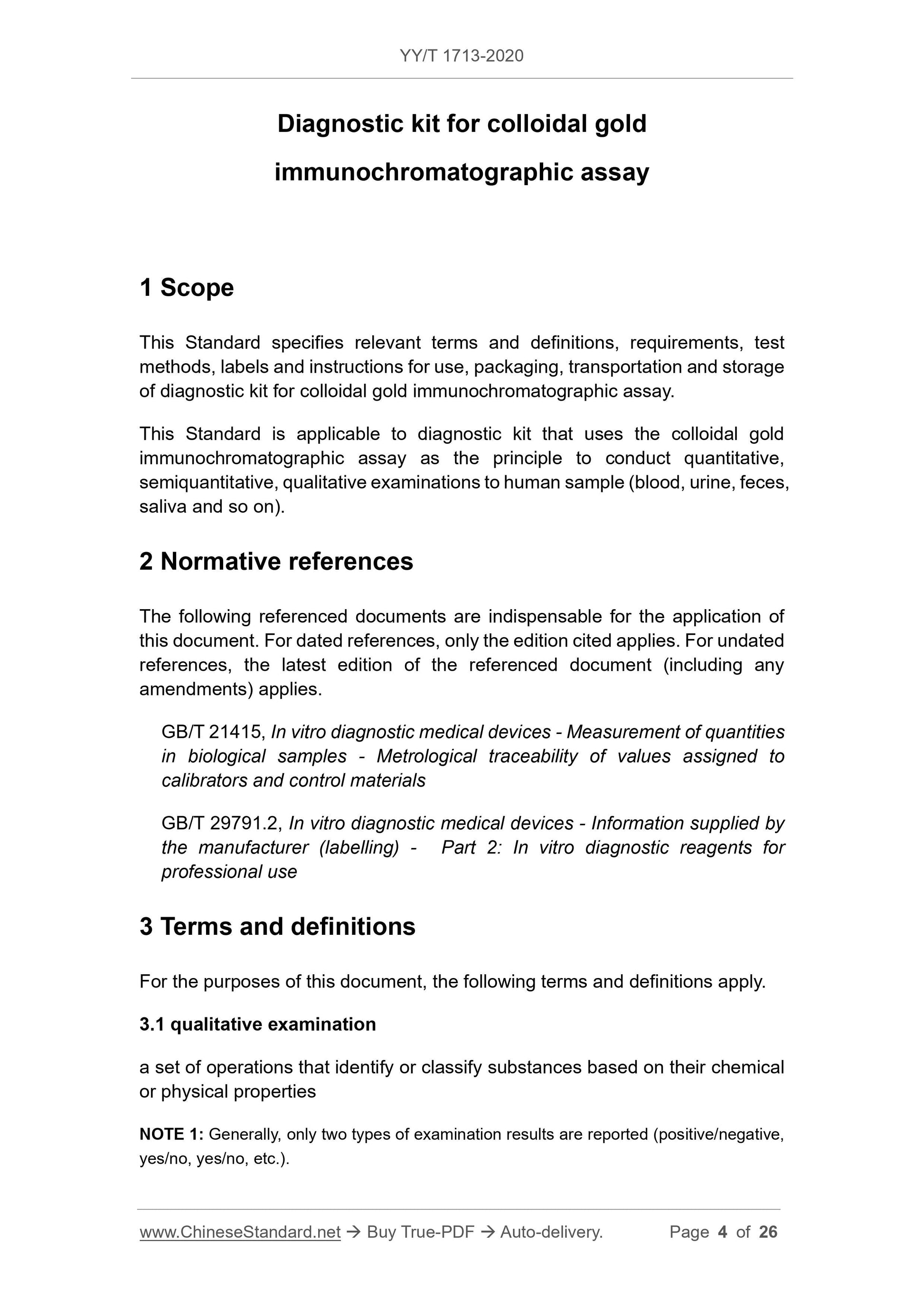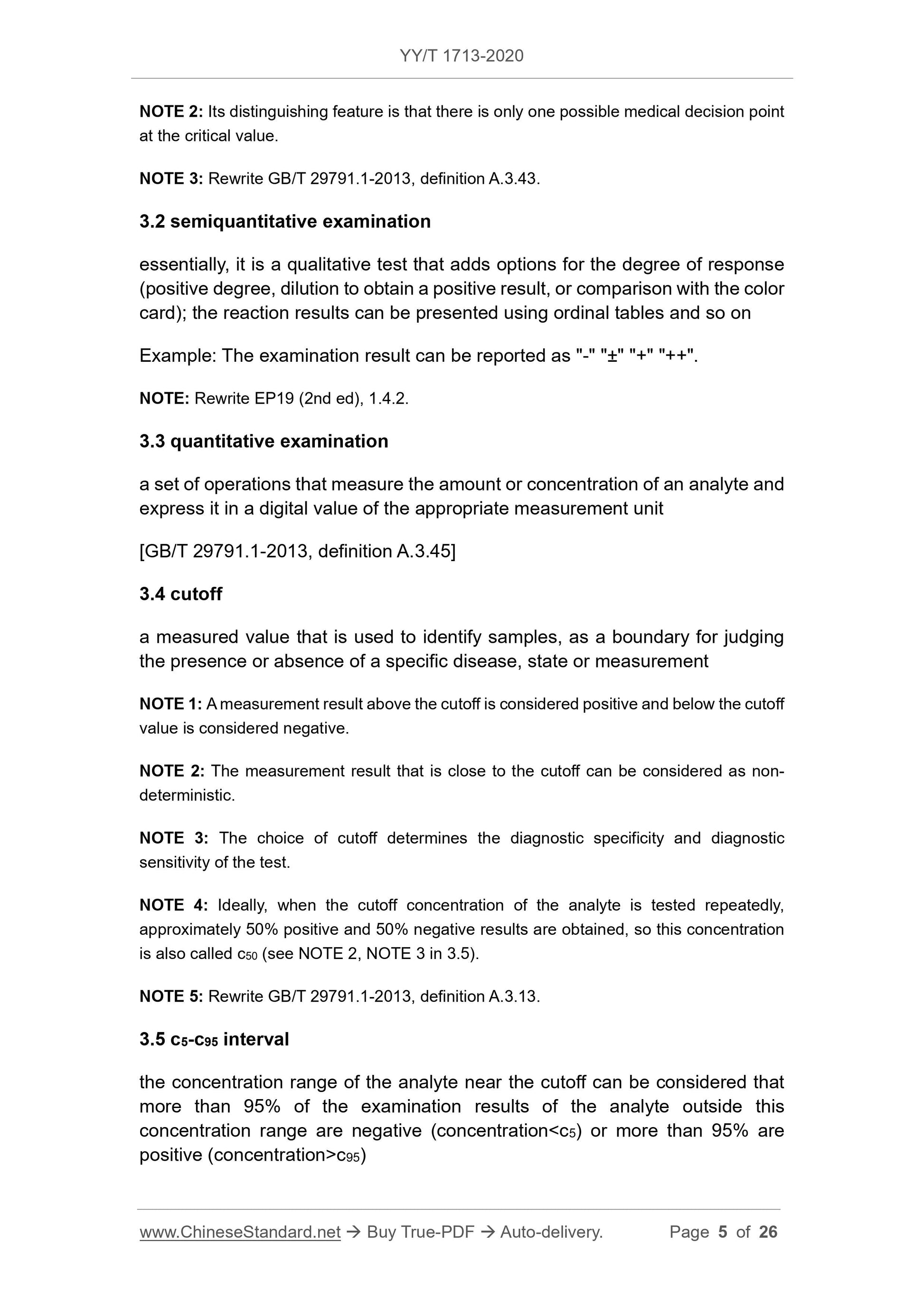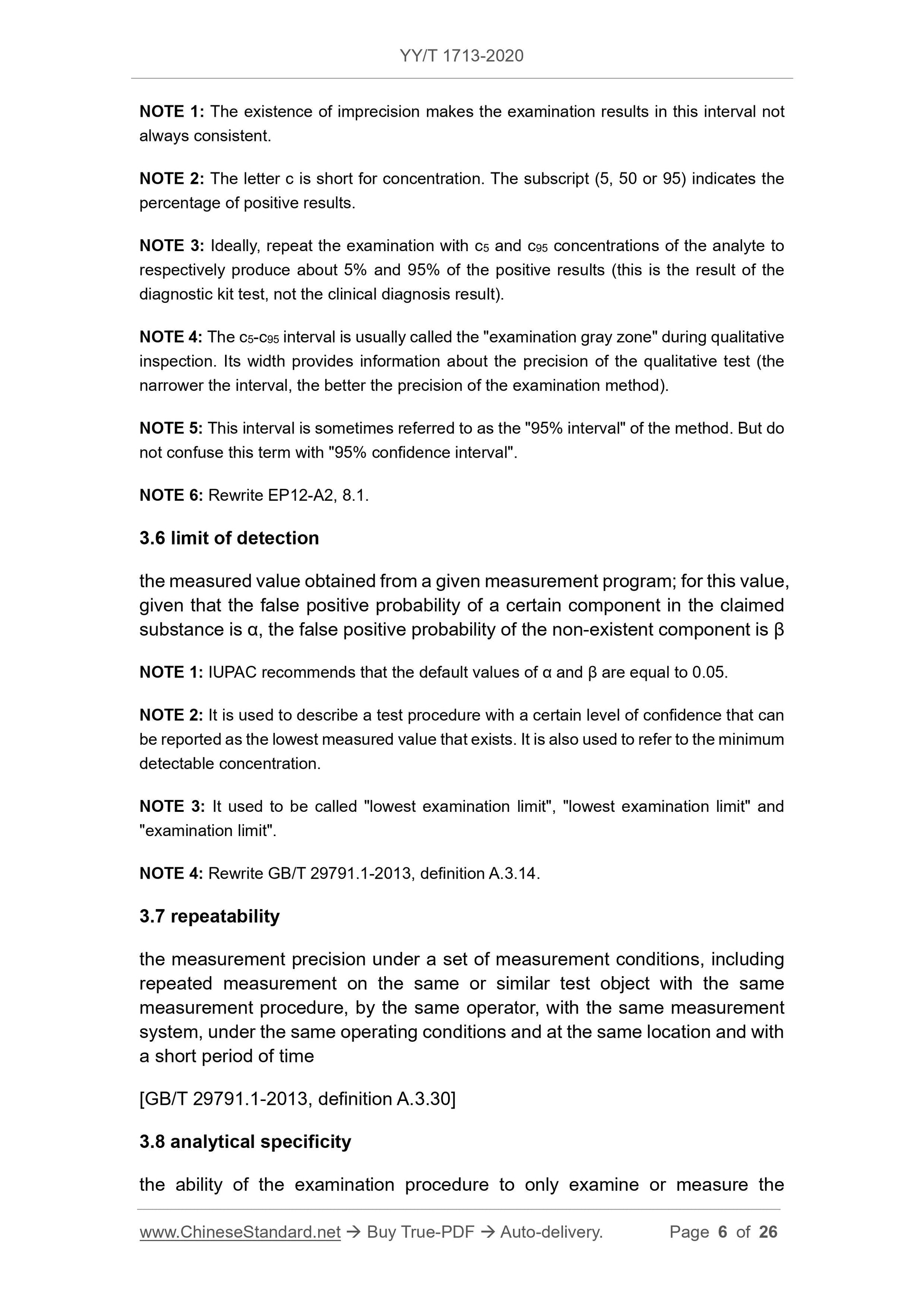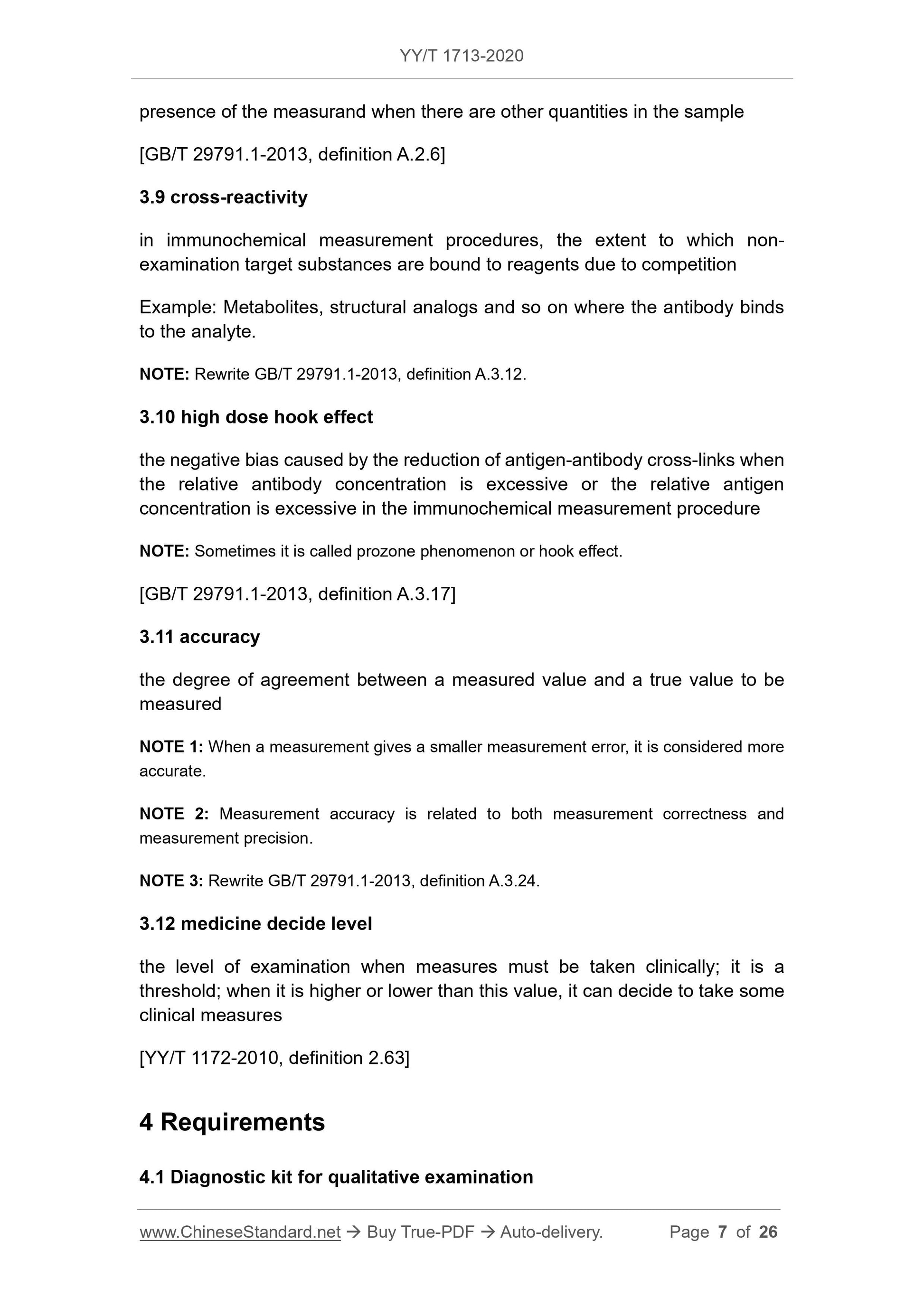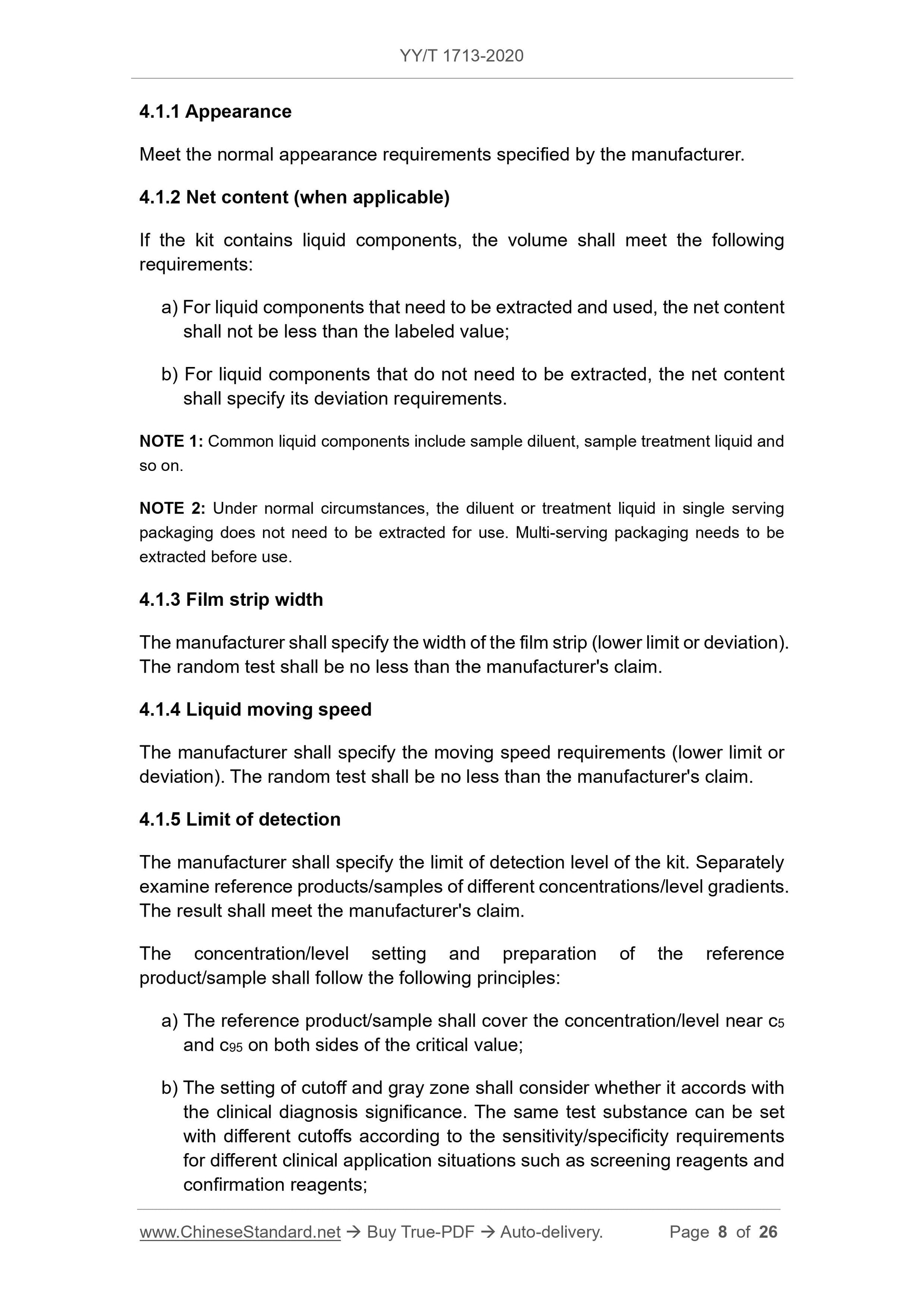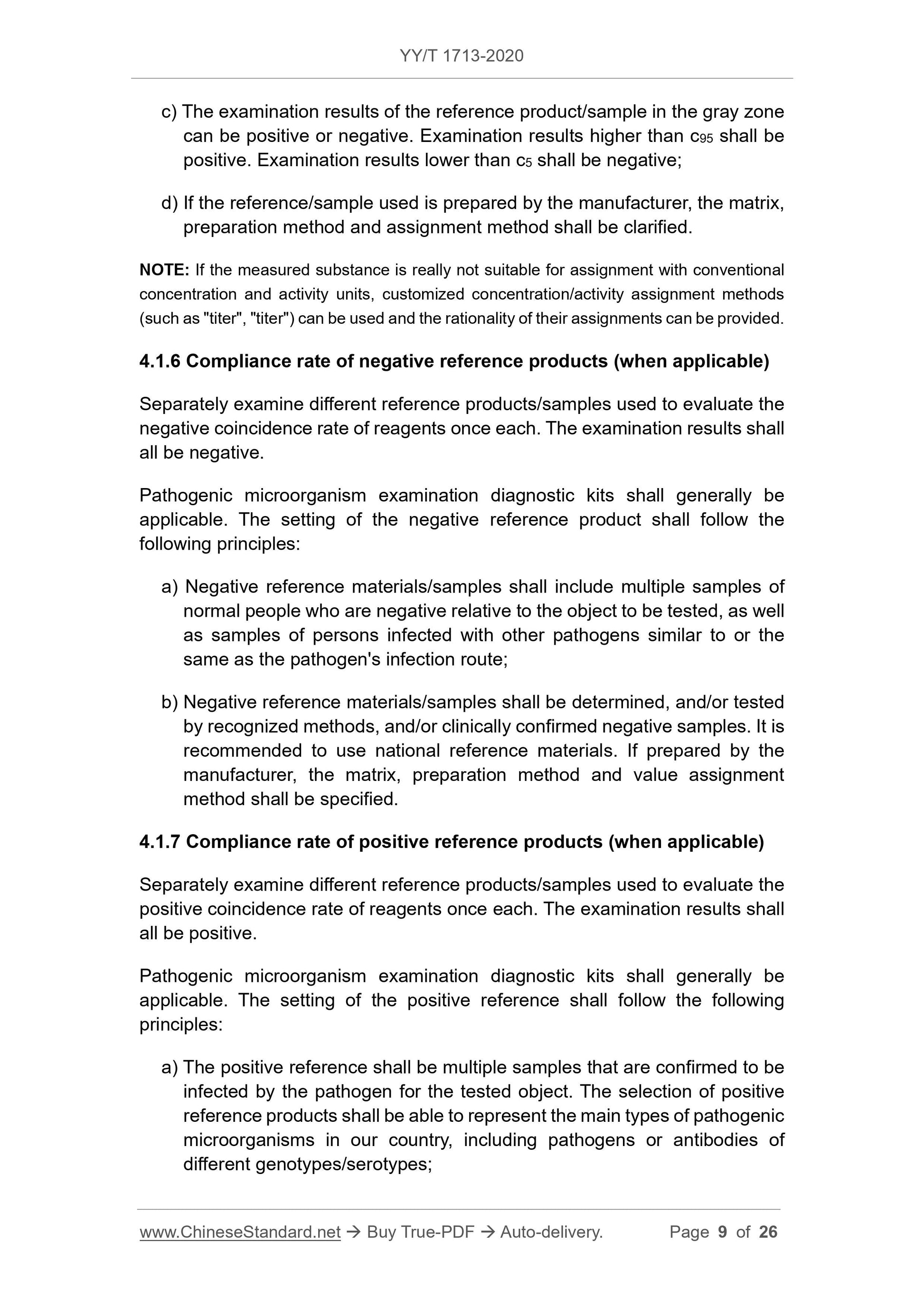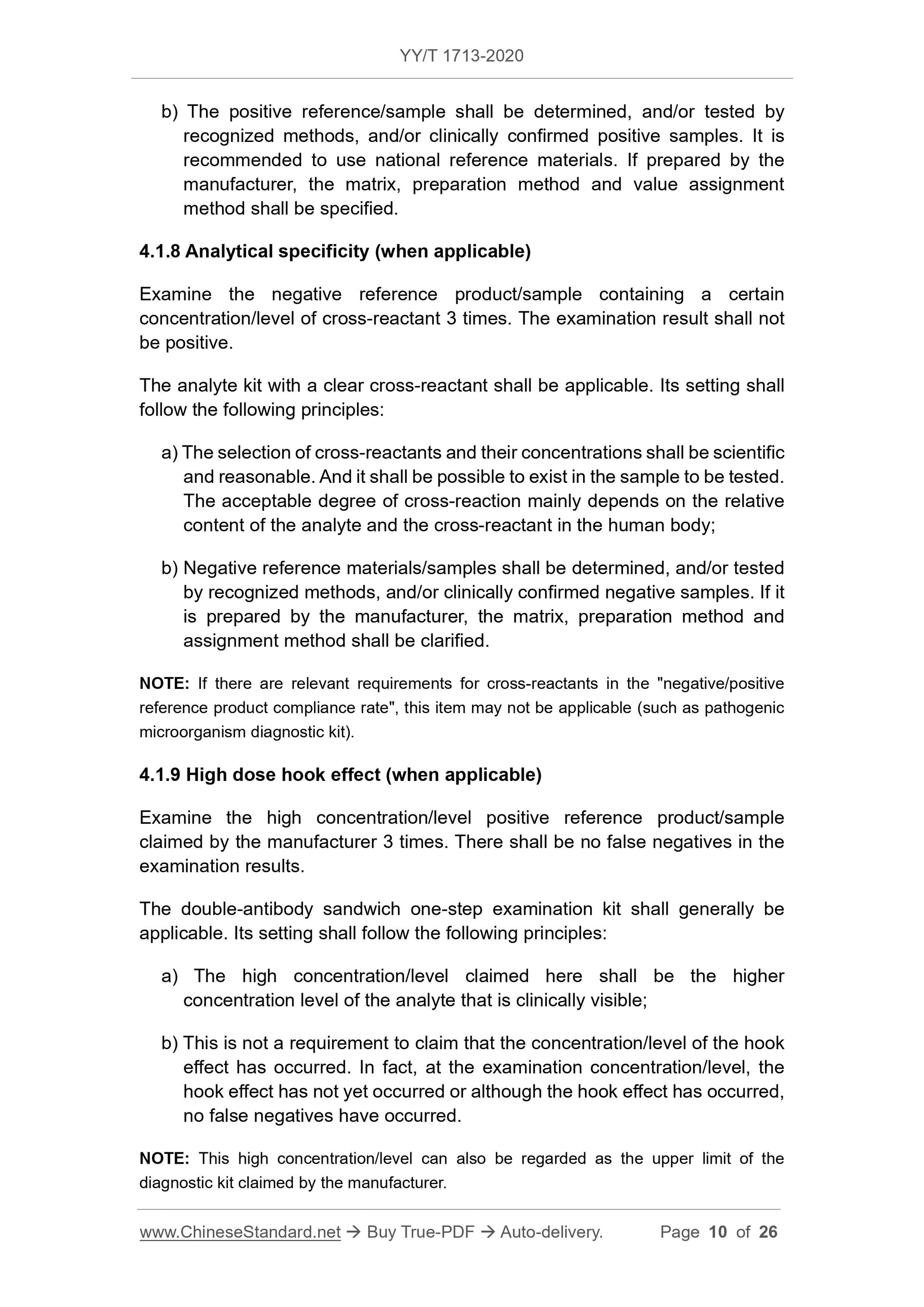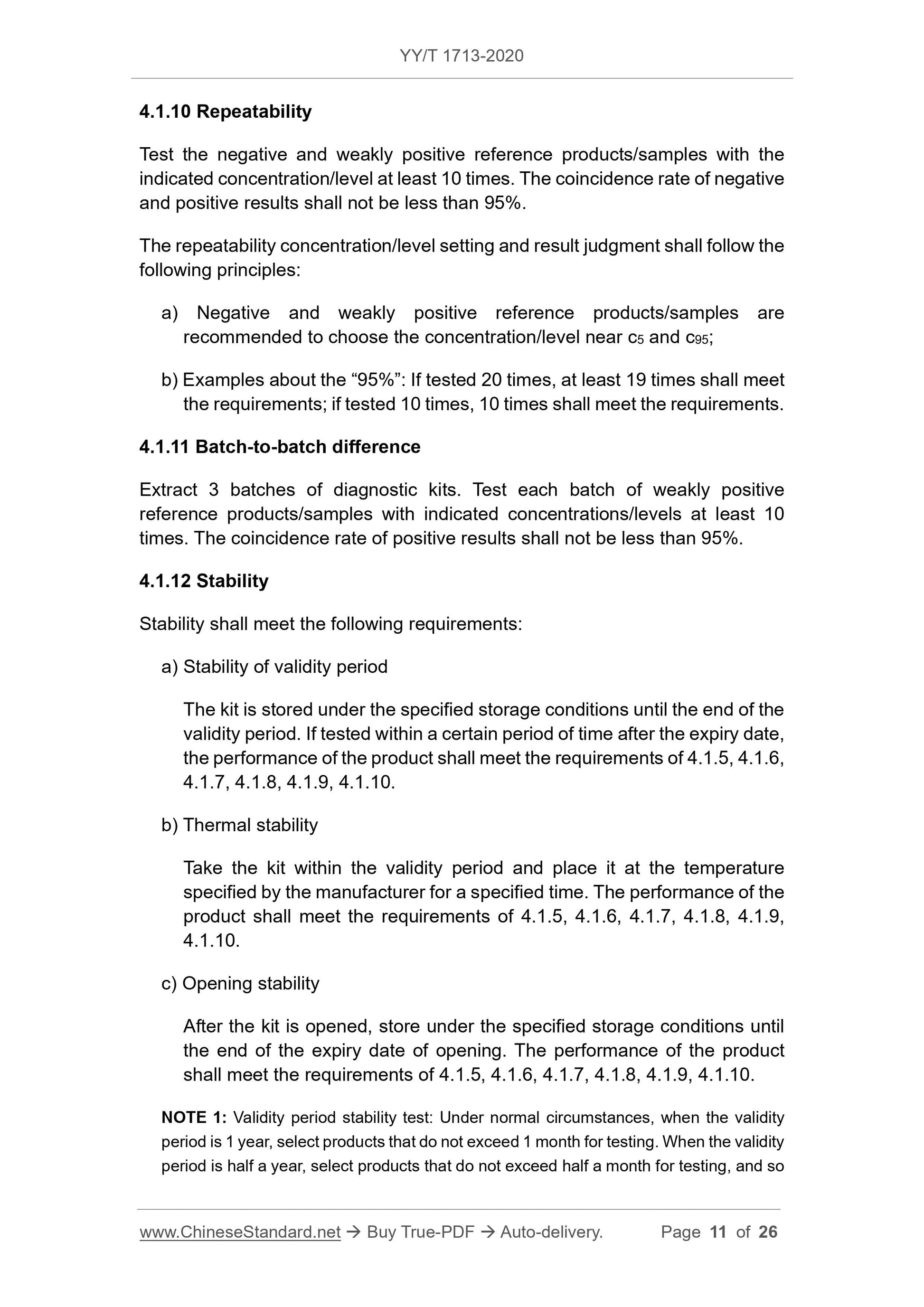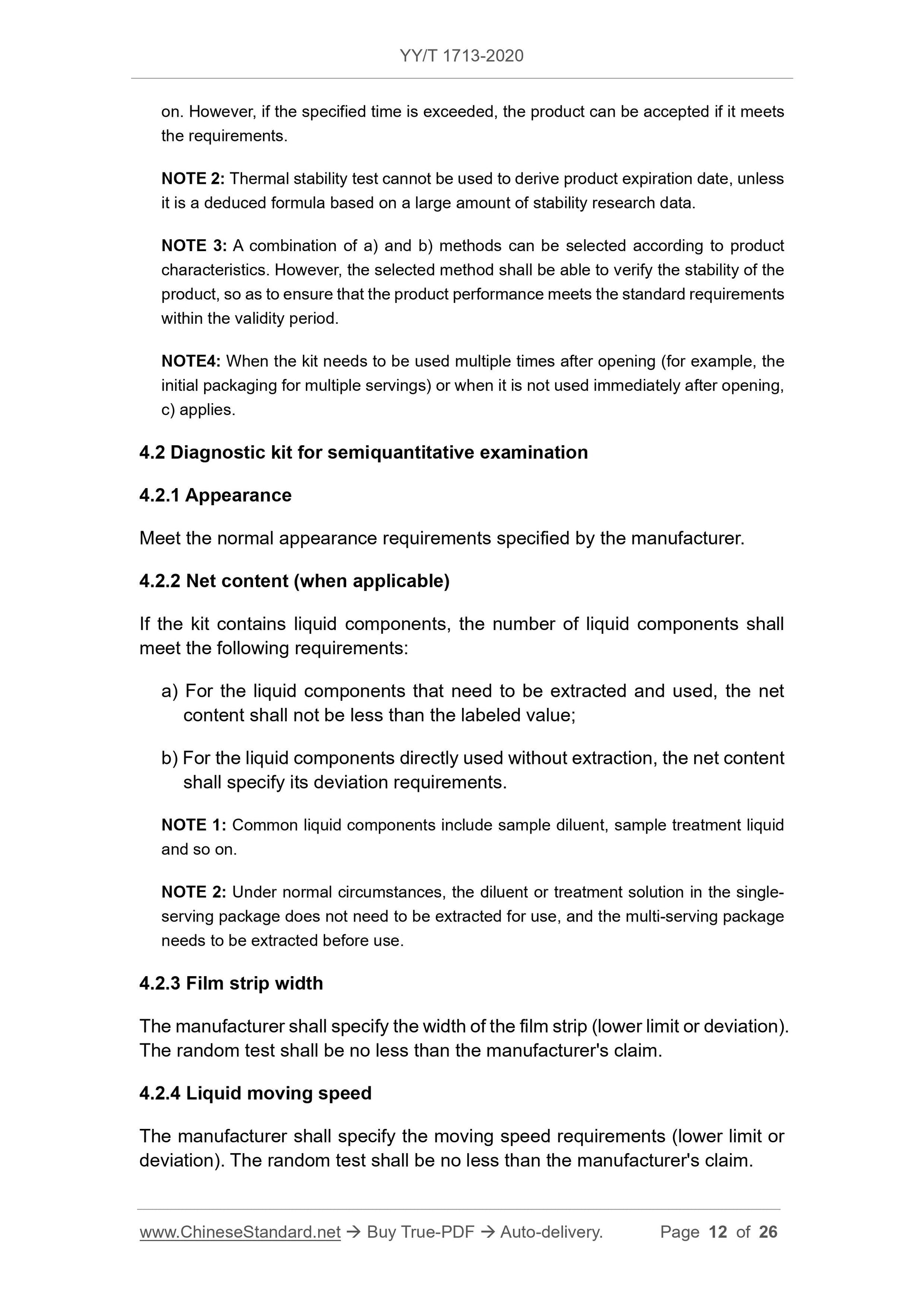1
/
의
12
PayPal, credit cards. Download editable-PDF & invoice in 1 second!
YY/T 1713-2020 English PDF (YYT1713-2020)
YY/T 1713-2020 English PDF (YYT1713-2020)
정가
$260.00 USD
정가
할인가
$260.00 USD
단가
/
단위
배송료는 결제 시 계산됩니다.
픽업 사용 가능 여부를 로드할 수 없습니다.
Delivery: 3 seconds. Download true-PDF + Invoice.
Get QUOTATION in 1-minute: Click YY/T 1713-2020
Historical versions: YY/T 1713-2020
Preview True-PDF (Reload/Scroll if blank)
YY/T 1713-2020: Diagnostic kit for colloidal gold immunochromatographic assay
YY/T 1713-2020
YY
PHARMACEUTICAL INDUSTRY STANDARD
OF THE PEOPLE’S REPUBLIC OF CHINA
ICS 11.100
C 44
Diagnostic kit for colloidal gold
immunochromatographic assay
ISSUED ON: SEPTEMBER 27, 2020
IMPLEMENTED ON: JUNE 01, 2022
Issued by: National Medical Products Administration
Table of Contents
Foreword ... 3
1 Scope ... 4
2 Normative references ... 4
3 Terms and definitions ... 4
4 Requirements ... 7
5 Test methods ... 18
6 Labels and instructions for use ... 24
7 Packaging, transportation and storage ... 25
Bibliography ... 26
Diagnostic kit for colloidal gold
immunochromatographic assay
1 Scope
This Standard specifies relevant terms and definitions, requirements, test
methods, labels and instructions for use, packaging, transportation and storage
of diagnostic kit for colloidal gold immunochromatographic assay.
This Standard is applicable to diagnostic kit that uses the colloidal gold
immunochromatographic assay as the principle to conduct quantitative,
semiquantitative, qualitative examinations to human sample (blood, urine, feces,
saliva and so on).
2 Normative references
The following referenced documents are indispensable for the application of
this document. For dated references, only the edition cited applies. For undated
references, the latest edition of the referenced document (including any
amendments) applies.
GB/T 21415, In vitro diagnostic medical devices - Measurement of quantities
in biological samples - Metrological traceability of values assigned to
calibrators and control materials
GB/T 29791.2, In vitro diagnostic medical devices - Information supplied by
the manufacturer (labelling) - Part 2: In vitro diagnostic reagents for
professional use
3 Terms and definitions
For the purposes of this document, the following terms and definitions apply.
3.1 qualitative examination
a set of operations that identify or classify substances based on their chemical
or physical properties
NOTE 1: Generally, only two types of examination results are reported (positive/negative,
yes/no, yes/no, etc.).
NOTE 1: The existence of imprecision makes the examination results in this interval not
always consistent.
NOTE 2: The letter c is short for concentration. The subscript (5, 50 or 95) indicates the
percentage of positive results.
NOTE 3: Ideally, repeat the examination with c5 and c95 concentrations of the analyte to
respectively produce about 5% and 95% of the positive results (this is the result of the
diagnostic kit test, not the clinical diagnosis result).
NOTE 4: The c5-c95 interval is usually called the "examination gray zone" during qualitative
inspection. Its width provides information about the precision of the qualitative test (the
narrower the interval, the better the precision of the examination method).
NOTE 5: This interval is sometimes referred to as the "95% interval" of the method. But do
not confuse this term with "95% confidence interval".
NOTE 6: Rewrite EP12-A2, 8.1.
3.6 limit of detection
the measured value obtained from a given measurement program; for this value,
given that the false positive probability of a certain component in the claimed
substance is α, the false positive probability of the non-existent component is β
NOTE 1: IUPAC recommends that the default values of α and β are equal to 0.05.
NOTE 2: It is used to describe a test procedure with a certain level of confidence that can
be reported as the lowest measured value that exists. It is also used to refer to the minimum
detectable concentration.
NOTE 3: It used to be called "lowest examination limit", "lowest examination limit" and
"examination limit".
NOTE 4: Rewrite GB/T 29791.1-2013, definition A.3.14.
3.7 repeatability
the measurement precision under a set of measurement conditions, including
repeated measurement on the same or similar test object with the same
measurement procedure, by the same operator, with the same measurement
system, under the same operating conditions and at the same location and with
a short period of time
[GB/T 29791.1-2013, definition A.3.30]
3.8 analytical specificity
the ability of the examination procedure to only examine or measure the
4.1.1 Appearance
Meet the normal appearance requirements specified by the manufacturer.
4.1.2 Net content (when applicable)
If the kit contains liquid components, the volume shall meet the following
requirements:
a) For liquid components that need to be extracted and used, the net content
shall not be less than the labeled value;
b) For liquid components that do not need to be extracted, the net content
shall specify its deviation requirements.
NOTE 1: Common liquid components include sample diluent, sample treatment liquid and
so on.
NOTE 2: Under normal circumstances, the diluent or treatment liquid in single serving
packaging does not need to be extracted for use. Multi-serving packaging needs to be
extracted before use.
4.1.3 Film strip width
The manufacturer shall specify the width of the film strip (lower limit or deviation).
The random test shall be no less than the manufacturer's claim.
4.1.4 Liquid moving speed
The manufacturer shall specify the moving speed requirements (lower limit or
deviation). The random test shall be no less than the manufacturer's claim.
4.1.5 Limit of detection
The manufacturer shall specify the limit of detection level of the kit. Separately
examine reference products/samples of different concentrations/level gradients.
The result shall meet the manufacturer's claim.
The concentration/level setting and preparation of the reference
product/sample shall follow the following principles:
a) The reference product/sample shall cover the concentration/level near c5
and c95 on both sides of the critical value;
b) The setting of cutoff and gray zone shall consider whether it accords with
the clinical diagnosis significance. The same test substance can be set
with different cutoffs according to the sensitivity/specificity requirements
for different clinical application situations such as screening reagents and
confirmation reagents;
b) The positive reference/sample shall be determined, and/or tested by
recognized methods, and/or clinically confirmed positive samples. It is
recommended to use national reference materials. If prepared by the
manufacturer, the matrix, preparation method and value assignment
method shall be specified.
4.1.8 Analytical specificity (when applicable)
Examine the negative reference product/sample containing a certain
concentration/level of cross-reactant 3 times. The examination result shall not
be positive.
The analyte kit with a clear cross-reactant shall be applicable. Its setting shall
follow the following principles:
a) The selection of cross-reactants and their concentrations shall be scientific
and reasonable. And it shall be possible to exist in the sample to be tested.
The acceptable degree of cross-reaction mainly depends on the relative
content of the analyte and the cross-reactant in the human body;
b) Negative reference materials/samples shall be determined, and/or tested
by recognized methods, and/or clinically confirmed negative samples. If it
is prepared by the manufacturer, the matrix, preparation method and
assignment method shall be clarified.
NOTE: If there are relevant requirements for cross-reactants in the "negative/positive
reference product compliance rate"...
Get QUOTATION in 1-minute: Click YY/T 1713-2020
Historical versions: YY/T 1713-2020
Preview True-PDF (Reload/Scroll if blank)
YY/T 1713-2020: Diagnostic kit for colloidal gold immunochromatographic assay
YY/T 1713-2020
YY
PHARMACEUTICAL INDUSTRY STANDARD
OF THE PEOPLE’S REPUBLIC OF CHINA
ICS 11.100
C 44
Diagnostic kit for colloidal gold
immunochromatographic assay
ISSUED ON: SEPTEMBER 27, 2020
IMPLEMENTED ON: JUNE 01, 2022
Issued by: National Medical Products Administration
Table of Contents
Foreword ... 3
1 Scope ... 4
2 Normative references ... 4
3 Terms and definitions ... 4
4 Requirements ... 7
5 Test methods ... 18
6 Labels and instructions for use ... 24
7 Packaging, transportation and storage ... 25
Bibliography ... 26
Diagnostic kit for colloidal gold
immunochromatographic assay
1 Scope
This Standard specifies relevant terms and definitions, requirements, test
methods, labels and instructions for use, packaging, transportation and storage
of diagnostic kit for colloidal gold immunochromatographic assay.
This Standard is applicable to diagnostic kit that uses the colloidal gold
immunochromatographic assay as the principle to conduct quantitative,
semiquantitative, qualitative examinations to human sample (blood, urine, feces,
saliva and so on).
2 Normative references
The following referenced documents are indispensable for the application of
this document. For dated references, only the edition cited applies. For undated
references, the latest edition of the referenced document (including any
amendments) applies.
GB/T 21415, In vitro diagnostic medical devices - Measurement of quantities
in biological samples - Metrological traceability of values assigned to
calibrators and control materials
GB/T 29791.2, In vitro diagnostic medical devices - Information supplied by
the manufacturer (labelling) - Part 2: In vitro diagnostic reagents for
professional use
3 Terms and definitions
For the purposes of this document, the following terms and definitions apply.
3.1 qualitative examination
a set of operations that identify or classify substances based on their chemical
or physical properties
NOTE 1: Generally, only two types of examination results are reported (positive/negative,
yes/no, yes/no, etc.).
NOTE 1: The existence of imprecision makes the examination results in this interval not
always consistent.
NOTE 2: The letter c is short for concentration. The subscript (5, 50 or 95) indicates the
percentage of positive results.
NOTE 3: Ideally, repeat the examination with c5 and c95 concentrations of the analyte to
respectively produce about 5% and 95% of the positive results (this is the result of the
diagnostic kit test, not the clinical diagnosis result).
NOTE 4: The c5-c95 interval is usually called the "examination gray zone" during qualitative
inspection. Its width provides information about the precision of the qualitative test (the
narrower the interval, the better the precision of the examination method).
NOTE 5: This interval is sometimes referred to as the "95% interval" of the method. But do
not confuse this term with "95% confidence interval".
NOTE 6: Rewrite EP12-A2, 8.1.
3.6 limit of detection
the measured value obtained from a given measurement program; for this value,
given that the false positive probability of a certain component in the claimed
substance is α, the false positive probability of the non-existent component is β
NOTE 1: IUPAC recommends that the default values of α and β are equal to 0.05.
NOTE 2: It is used to describe a test procedure with a certain level of confidence that can
be reported as the lowest measured value that exists. It is also used to refer to the minimum
detectable concentration.
NOTE 3: It used to be called "lowest examination limit", "lowest examination limit" and
"examination limit".
NOTE 4: Rewrite GB/T 29791.1-2013, definition A.3.14.
3.7 repeatability
the measurement precision under a set of measurement conditions, including
repeated measurement on the same or similar test object with the same
measurement procedure, by the same operator, with the same measurement
system, under the same operating conditions and at the same location and with
a short period of time
[GB/T 29791.1-2013, definition A.3.30]
3.8 analytical specificity
the ability of the examination procedure to only examine or measure the
4.1.1 Appearance
Meet the normal appearance requirements specified by the manufacturer.
4.1.2 Net content (when applicable)
If the kit contains liquid components, the volume shall meet the following
requirements:
a) For liquid components that need to be extracted and used, the net content
shall not be less than the labeled value;
b) For liquid components that do not need to be extracted, the net content
shall specify its deviation requirements.
NOTE 1: Common liquid components include sample diluent, sample treatment liquid and
so on.
NOTE 2: Under normal circumstances, the diluent or treatment liquid in single serving
packaging does not need to be extracted for use. Multi-serving packaging needs to be
extracted before use.
4.1.3 Film strip width
The manufacturer shall specify the width of the film strip (lower limit or deviation).
The random test shall be no less than the manufacturer's claim.
4.1.4 Liquid moving speed
The manufacturer shall specify the moving speed requirements (lower limit or
deviation). The random test shall be no less than the manufacturer's claim.
4.1.5 Limit of detection
The manufacturer shall specify the limit of detection level of the kit. Separately
examine reference products/samples of different concentrations/level gradients.
The result shall meet the manufacturer's claim.
The concentration/level setting and preparation of the reference
product/sample shall follow the following principles:
a) The reference product/sample shall cover the concentration/level near c5
and c95 on both sides of the critical value;
b) The setting of cutoff and gray zone shall consider whether it accords with
the clinical diagnosis significance. The same test substance can be set
with different cutoffs according to the sensitivity/specificity requirements
for different clinical application situations such as screening reagents and
confirmation reagents;
b) The positive reference/sample shall be determined, and/or tested by
recognized methods, and/or clinically confirmed positive samples. It is
recommended to use national reference materials. If prepared by the
manufacturer, the matrix, preparation method and value assignment
method shall be specified.
4.1.8 Analytical specificity (when applicable)
Examine the negative reference product/sample containing a certain
concentration/level of cross-reactant 3 times. The examination result shall not
be positive.
The analyte kit with a clear cross-reactant shall be applicable. Its setting shall
follow the following principles:
a) The selection of cross-reactants and their concentrations shall be scientific
and reasonable. And it shall be possible to exist in the sample to be tested.
The acceptable degree of cross-reaction mainly depends on the relative
content of the analyte and the cross-reactant in the human body;
b) Negative reference materials/samples shall be determined, and/or tested
by recognized methods, and/or clinically confirmed negative samples. If it
is prepared by the manufacturer, the matrix, preparation method and
assignment method shall be clarified.
NOTE: If there are relevant requirements for cross-reactants in the "negative/positive
reference product compliance rate"...
Share
